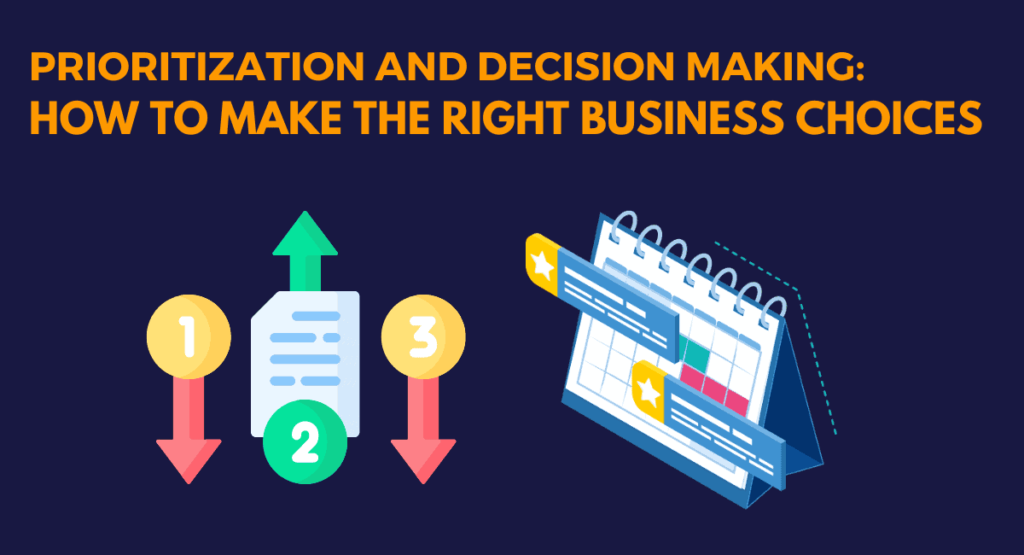Prioritization and Decision Making: How to Make the Right Business Choices


As a business leader, you must quickly make decisions for the business to progress.
You must weigh various factors when making these critical choices and prioritize the options to make the best decision possible.
Considering all available data points, weighing their importance, and understanding which should shape your choices to prioritize and make decisions is critical. This is essential for maintaining a strong regulatory compliance posture and financial stability.
In this blog post, we’ll discuss several strategies and tips that will help guide you through this process so that you can gain increased confidence in deciding upon business initiatives moving forward.
Making Decisions and Prioritizing Projects in Business
Making decisions and prioritizing projects are two essential skills for any business leader. After all, a business that isn’t making smart decisions and prioritizing suitable projects can quickly find itself in trouble.
But how do you know what decisions to make and which projects to prioritize?
Why Decision-Making and Prioritization Are So Important
Every business leader has to make hundreds of decisions every day. You must determine which projects should receive priority, assign the necessary resources, designate who will be responsible for each project, and more.
Making good decisions could save time, money, and effort on projects that don’t lead anywhere.
That’s why it’s so crucial for business leaders to take the time to consider their options before making a decision.
Prioritization is just as important as decision-making—maybe even more so. If you don’t prioritize your projects correctly, you could end up neglecting the ones most important while spending too much time on those that won’t help your business grow.
That’s why it’s so crucial for business leaders to evaluate their projects carefully before deciding which ones should get priority treatment over others.
Prioritization Made Simple

“A core element of productivity is prioritization. You don’t have to do everything on your to-do list.” Joey Justice.
Prioritization is a skill that’s essential for any executive or manager –– it helps you manage your time, make sure important tasks get done first, and ensure your team is working on the most pressing issues.
The Definition of Prioritization
Deciding which tasks are of greater importance than others is the essence of prioritization.
All tasks must be evaluated and sorted, with the most critical tasks tackled first.
Management aims to complete the tasks that affect the organization as quickly and efficiently as possible.
Why Is Prioritization Important?
Prioritization is essential because it helps you focus on tasks impacting your organization’s success. Prioritizing tasks helps free up resources that you can allocate toward activities more likely to generate revenue or save money in the long run. Finally, prioritizing tasks ensures that everything gets done efficiently and prevents unnecessary delays due to trying to do too much at once.
How Do You Prioritize Tasks?

It’s important to remember that no two organizations are alike, so what works for one may not necessarily work for another.
However, there are some basic steps you can take when trying to prioritize tasks:
• Identify what needs to be done by writing down all of your tasks; this will help you visualize how much work needs to be done and allow you to prioritize accordingly
• Estimate how long each task will take; this will give you a better idea of which ones need more attention than others
• Analyze each task’s importance; think about how each task fits into your overall goals and objectives
• Assign deadlines for completion; this will help keep everyone accountable and ensure things get done on time
• Evaluate progress regularly; make sure everyone is working towards their goals and adjust as needed
• Delegate appropriately; don’t try to do everything yourself – delegate specific tasks so everyone can contribute
• Measure results; see if your efforts have paid off by checking metrics such as engagement, sales figures, Etc.
Tips for Prioritizing Projects

When prioritizing projects, you establish specific goals by identifying the necessary steps and then methodically working towards those objectives. Start by setting clear objectives for each project:
- What do you want it to accomplish?
- How will success be measured?
- When should it be completed by?
Setting specific goals ahead of time will make it easier for you to prioritize tasks efficiently to achieve those objectives on schedule.
Additionally, it breaks down large tasks into smaller steps that you can quickly achieve one at a time; this helps keep things organized while giving everyone involved an idea of progress toward achieving larger goals.
Tips for Making Better Decisions
The most effective way to make better decisions is by gathering as much information as possible about the situation before making a call.
Take the time to research all available options, consult with experts in the field if necessary, talk with clients or colleagues about their experiences with similar situations, Etc., before making a decision.
If you take the time to gather all the necessary information, you will be well-equipped to make an informed decision when the time comes to take action.
The Decision-Making Process

Making decisions is an unavoidable part of life. Whether you’re a CEO deciding how to manage a crisis or a manager making essential choices about allocating resources, making sound decisions quickly and efficiently is critical.
But how do we make sure our decisions are the right ones?
Let’s look at the decision-making process and explore some best practices for weighing options and coming to an informed conclusion.
1. Understand Your Objective
Every decision should have an objective – something that you want to achieve. Before deciding, it’s important to understand this goal and be clear about what success looks like.
Doing so ensures that your decision is in line with your desired outcome.
2. Gather Information
Once you understand your objective, it’s time to gather information to help inform your decision. Gathering information includes:
- Researching industry trends.
- Talking with experts in the field.
- Consulting with colleagues who may have relevant experience.
- Running experiments or tests if necessary.
Ensure all potential options are on the table before getting to business; some of the best solutions often come from outside sources!
3. Weigh Your Options
Now that you have collected and organized all your information, it’s time to weigh your options.
Consider each option carefully and objectively; don’t let biases influence your opinion one way or another! Also, consider both sides of any argument; sometimes, seemingly counterintuitive solutions are the best ones in hindsight.
Finally, consider every possible consequence of each option—especially those that might not be as obvious at first glance—to ensure you make an informed decision based on all available facts.
The Role of Research and Data
Research and data play an important role in decision-making. When trying to make a well-informed decision, it is essential to gather as much information as possible.
This includes researching available options, reading reviews or testimonials from others who have used those options before you, and even consulting with experts in the field if necessary.
Gathering relevant data will help you better understand each option’s benefits and drawbacks to make an informed decision based on facts rather than assumptions.
The Role of Intuition
While it is important to consider facts and figures when making a decision, intuition also plays an important role. Without intuition guiding our decisions, we can quickly become overwhelmed by too much information or swayed by extraneous factors such as emotion.
To make sure your decision is based on sound reasoning rather than emotion or impulse, take some time to reflect on your choices before making a final call.
Consider how each option fits into your overall goals and values; this will help ensure that you decide to align with your long-term objectives instead of pursuing something simply because it feels good at the moment.
How to Avoid Common Decision-Making Mistakes

Making decisions is a part of life. But making wise, informed, and well—thought—out decisions isn’t easy.
It requires taking the time to consider all relevant information, weighing the options carefully, and then making a choice.
All too often, though, people make hasty decisions without giving them the proper attention they deserve.
Here’s an overview of common decision-making mistakes and how you can avoid them in your own life.
Rushing into Decisions
The common mistake people make is rushing into their choices without thinking things through.
This can lead to poor decisions with far-reaching consequences that organizations could have avoided if they had only taken more time to analyze all aspects of the situation.
To avoid this mistake, take a step back from any decisions you need to make and give yourself time to consider all available options before settling on one.
Overconfidence Bias
Another mistake people often make when making decisions is overconfidence bias—the tendency to overestimate one’s knowledge or abilities.
Overconfidence bias can result in poor decision-making, leading individuals to believe they know more than they do. To avoid this mistake, get input from others whenever possible instead of relying solely on your judgment.
It’s also important to remember that no one has all the answers; therefore, it’s always important to remain open-minded about different perspectives and opinions when making important choices.
Fear of Failure
The fear of failure can also be a significant obstacle to decision-making. People may be hesitant or unwilling to take risks due to fear of potential negative outcomes or embarrassment if they fail at something new or unfamiliar.
- To combat this thinking, remind yourself that failure isn’t necessarily bad; it can be an invaluable learning experience if you take away valuable lessons that help you grow as a person and as a professional moving forward.
Utilizing Prioritization and Decision-Making Tools to Improve Your Business

Making decisions can be challenging. Balancing resources, risks, and rewards is a challenge for any leader. Fortunately, there are tools available to help you make decisions with confidence.
From decision trees to SWOT analysis, understanding what prioritization and decision-making tools are available and how to use them effectively can go a long way in helping your business succeed.
Decision Trees – A Simple Tool For Complex Decisions
Decision trees are visual charts that help you weigh the risks and rewards of different decisions. Each section of the tree represents a possible outcome or action a leader could take.
By analyzing each outcome carefully, it’s possible to determine which option will yield the best results for your business.
For example, suppose you’re considering investing in a new product line but unsure whether it’s financially feasible. In that case, you could create a decision tree outlining the potential financial benefits and associated risks.
Deciding which path is most profitable for your business by visually tracking these variables becomes much easier.
SWOT Analysis – Analyzing Strengths and Weaknesses
“Strengths, Weaknesses, Opportunities, Threats” or SWOT is another popular tool executives use when making crucial business decisions.
This tool helps identify strengths in your current processes and weaknesses that need improvement, opportunities that may arise in the future, and threats that could potentially harm your business if not addressed quickly enough.
By doing an honest SWOT analysis of your organization, you can gain valuable insights into where improvements need to be made and where the organization should allocate resources to get the best possible return on investment (ROI).
Conclusion
Prioritizing and making decisions in business is an essential skill for achieving success. With proper techniques, criteria, and tools, decision-making can be an effective process that leads to better results.
It is important to remember the common mistakes many make when making decisions and take steps to avoid them. We have presented a helpful overview of essential topics on appropriate prioritization and decision-making rituals and practices that can support this endeavor.
Hopefully, this article has equipped you with actionable insights to prioritize tasks correctly and make informed decisions.
We urge you to weigh everything carefully before arriving at a conclusion, ensuring high-priority activities are addressed first and given your high effort. Let’s all put our best foot forward for the success of your businesses!


